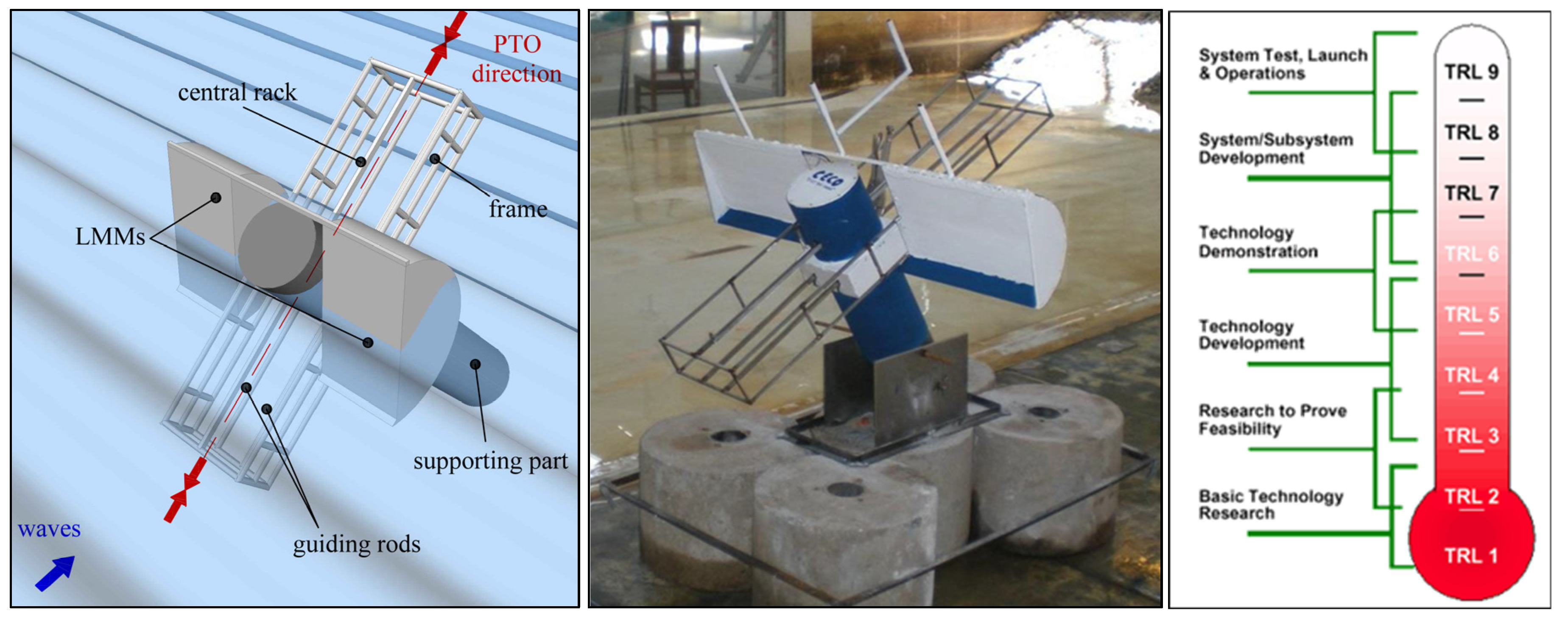The Wave Energy Converter CECO: Current Status and Future Perspectives †
Abstract
:1. Introduction
2. The TRL Scale
3. Progress in the Development of CECO
3.1. TRL 1-2
3.2. TRL-3
- the mechanical friction losses in the rack-pinion system have to be reduced in order to maximize the WEC’s efficiency;
- the current CECO geometry performs better at sites with milder wave conditions;
- the PTO inclination plays a relevant role in the performance of the WEC, being the configurations with 30 and 45º of inclination those with a better performance; and
- the performance of CECO slightly decreases with the operating water depth.
4. Conclusions and Future Work
- the mechanical conversion machinery (rack-pinion and gear system);
- the structural configuration and materials, including the foundation and the survival mode; and
- the electric and electronic components, including an ad-hoc control strategy.
Author Contributions
Funding
Acknowledgments
Conflicts of Interest
References
- Edenhofer, O.; Pichs-Madruga, R.; Sokona, Y.; Seyboth, K.; Matschoss, P.; Kadner, S.; Zwickel, T.; Eickemeier, P.; Hansen, G.; Schlömer, S.; et al. IPCC Special Report on Renewable Energy Sources and Climate Change Mitigation; Prep by Work Group III Intergovernmental Panel Clim Chang; Cambridge Univresity Press: Cambridge, UK, 2011. [Google Scholar]
- Antonio, F.D. Wave energy utilization: A review of the technologies. Renew. Sustain. Energy Rev. 2010, 14, 899–918. [Google Scholar] [CrossRef]
- Taveira-Pinto, F.; Iglesias, G.; Rosa-Santos, P.; Deng, ZD. Preface to Special Topic: Marine Renewable Energy. J. Renew. Sustain. Energy 2015, 7, 5. [Google Scholar] [CrossRef]
- Ruehl, K.; Bull, D. Wave energy development roadmap: Design to commercialization. In Proceedings of the 2012 Oceans, Hampton Roads, VA, USA, 14–19 October 2012; pp. 1–10. [Google Scholar]
- Rosa-Santos, P.; Taveira-Pinto, F.; Teixeira, L.; Ribeiro, J. CECO wave energy converter: Experimental proof of concept. J. Renew. Sustain. Energy 2015, 7, 61704. [Google Scholar] [CrossRef]
- Rosa-Santos, P.; Taveira-Pinto, F.; Pinho-Ribeiro, J.; Teixeira, L.; Marinheiro, J. Harnessing the kinetic and potential wave energy: Design and development of a new wave energy converter. In Renewable Energies Offshore; Guedes, S.C., Ed.; CRC Press, Taylor & Francis Group: London, UK, 2015; pp. 367–374. [Google Scholar]
- López, M.; Taveira-Pinto, F.; Rosa-Santos, P. Numerical modelling of the CECO wave energy converter. Renew. Energy 2017, 113, 202–210. [Google Scholar] [CrossRef]
- López, M.; Taveira-Pinto, F.; Rosa-Santos, P. Influence of the power take-off characteristics on the performance of CECO wave energy converter. Energy 2017, 120, 686–697. [Google Scholar] [CrossRef]
- López, M.; Ramos, V.; Rosa-Santos, P.; Taveira-Pinto, F. Effects of the PTO inclination on the performance of the CECO wave energy converter. Mar. Struct. 2018, 61, 452–466. [Google Scholar] [CrossRef]
- Ramos, V.; López, M.; Taveira-Pinto, F.; Rosa-Santos, P. Influence of the wave climate seasonality on the performance of a wave energy converter: A case study. Energy 2017, 135, 303–316. [Google Scholar] [CrossRef]
- Ramos, V.; López, M.; Taveira-Pinto, F.; Rosa-Santos, P. Performance assessment of the CECO wave energy converter: Water depth influence. Renew. Energy 2018, 117, 341–356. [Google Scholar] [CrossRef]
- Lopez, M.; Lopez, I.; Iglesias, G.; López, M.; López, I.; Iglesias, G. Hindcasting Long Waves in a Port: An ANN Approach. Coast. Eng. J. 2015, 57, 1550019. [Google Scholar] [CrossRef]
- López, I.; Iglesias, G. Efficiency of OWC wave energy converters: A virtual laboratory. Appl. Ocean Res. 2014, 44, 63–70. [Google Scholar] [CrossRef]


Publisher’s Note: MDPI stays neutral with regard to jurisdictional claims in published maps and institutional affiliations. |
© 2018 by the authors. Licensee MDPI, Basel, Switzerland. This article is an open access article distributed under the terms and conditions of the Creative Commons Attribution (CC BY) license (https://creativecommons.org/licenses/by/4.0/).
Share and Cite
López, M.; Rosa-Santos, P.; Taveira-Pinto, F.; Ramos, V.; Rodríguez, C.A. The Wave Energy Converter CECO: Current Status and Future Perspectives. Proceedings 2018, 2, 1423. https://doi.org/10.3390/proceedings2231423
López M, Rosa-Santos P, Taveira-Pinto F, Ramos V, Rodríguez CA. The Wave Energy Converter CECO: Current Status and Future Perspectives. Proceedings. 2018; 2(23):1423. https://doi.org/10.3390/proceedings2231423
Chicago/Turabian StyleLópez, Mario, Paulo Rosa-Santos, Francisco Taveira-Pinto, Víctor Ramos, and Claudio A. Rodríguez. 2018. "The Wave Energy Converter CECO: Current Status and Future Perspectives" Proceedings 2, no. 23: 1423. https://doi.org/10.3390/proceedings2231423
APA StyleLópez, M., Rosa-Santos, P., Taveira-Pinto, F., Ramos, V., & Rodríguez, C. A. (2018). The Wave Energy Converter CECO: Current Status and Future Perspectives. Proceedings, 2(23), 1423. https://doi.org/10.3390/proceedings2231423







